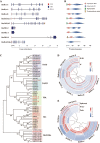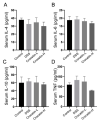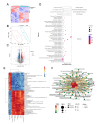Crocetin Prolongs Recovery Period of DSS-Induced Colitis via Altering Intestinal Microbiome and Increasing Intestinal Permeability
- PMID: 35409192
- PMCID: PMC8998954
- DOI: 10.3390/ijms23073832
Crocetin Prolongs Recovery Period of DSS-Induced Colitis via Altering Intestinal Microbiome and Increasing Intestinal Permeability
Abstract
Crocetin is one of the major active constituents of saffron (Crocus sativus L.) which has a reputation for facilitating blood circulation and dispersing blood stasis in traditional Chinese medicine. However, there is little evidence showing the relationship between crocetin intake and the risk of gastrointestinal diseases such as colitis. In order to investigate the effect of crocetin on the regulation of intestinal barrier function and intestinal microbiota composition, mice were treated with crocetin after 3% dextran sulfate sodium (DSS) administration for one week. We found that crocetin intake at 10 mg/kg aggravated colitis in mice, showing increased weight loss and more serious histological abnormalities compared with the DSS group. The 16s rDNA sequencing analysis of the feces samples showed that mice treated with 10 mg/kg crocetin had lower species diversity and richness than those treated with DSS. At the genus level, a higher abundance of Akkermansia and Mediterraneibacter, and a lower abundance of Muribaculaceae, Dubosiella, Paramuribaculum, Parasutterella, Allobaculum, Duncaniella, Candidatus Stoquefichus, and Coriobacteriaceae UCG-002 were observed in the crocetin group. Untargeted metabolomic analyses revealed that crocetin reduced the levels of primary and secondary bile acids such as 12-ketodeoxycholic acid, 7-ketodeoxycholic acid, 3-sulfodeoxycholic acid, 6-ethylchenodeoxycholic acid, chenodeoxycholate, glycochenodeoxycholate-7-sulfate, glycocholate, and sulfolithocholic acid in the colon. In conclusion, crocetin intake disturbed intestinal homeostasis and prolonged recovery of colitis by promoting inflammation and altering gut microbiota composition and its metabolic products in mice. Our findings suggest that patients with gastrointestinal diseases such as inflammatory bowel disease should use crocetin with caution.
Keywords: crocetin; gut microbiota; inflammatory bowel disease; intestinal metabolites; ulcerative colitis.
Conflict of interest statement
The authors declare no conflict of interest.
Figures










Similar articles
-
Gut microbiota dysbiosis in a novel mouse model of colitis potentially increases the risk of colorectal cancer.Am J Physiol Gastrointest Liver Physiol. 2025 Jun 1;328(6):G831-G847. doi: 10.1152/ajpgi.00040.2025. Epub 2025 May 5. Am J Physiol Gastrointest Liver Physiol. 2025. PMID: 40323196
-
Huangqin decoction ameliorates DSS-induced ulcerative colitis: Role of gut microbiota and amino acid metabolism, mTOR pathway and intestinal epithelial barrier.Phytomedicine. 2022 Jun;100:154052. doi: 10.1016/j.phymed.2022.154052. Epub 2022 Mar 14. Phytomedicine. 2022. PMID: 35344714
-
2,3,5,4'-Tetrahydroxystilbene-2-O-β-D-glucoside, a major bioactive component from Polygoni multiflori Radix (Heshouwu) suppresses DSS induced acute colitis in BALb/c mice by modulating gut microbiota.Biomed Pharmacother. 2021 May;137:111420. doi: 10.1016/j.biopha.2021.111420. Epub 2021 Feb 23. Biomed Pharmacother. 2021. PMID: 33761623
-
Saffron Pre-Treatment Promotes Reduction in Tissue Inflammatory Profiles and Alters Microbiome Composition in Experimental Colitis Mice.Molecules. 2021 Jun 2;26(11):3351. doi: 10.3390/molecules26113351. Molecules. 2021. PMID: 34199466 Free PMC article.
-
The Anti-hypoxia Potentials of Trans-sodium Crocetinate in Hypoxiarelated Diseases: A Review.Curr Radiopharm. 2024;17(1):30-37. doi: 10.2174/0118744710268127231020083505. Curr Radiopharm. 2024. PMID: 37877507 Review.
Cited by
-
Untargeted Metabolomics Revealed that Quercetin Inhibited Ferroptosis by Improving Metabolic Disorder in the Hippocampus of Perimenopausal Depression Model Rats.Mol Neurobiol. 2025 Mar;62(3):2872-2888. doi: 10.1007/s12035-024-04445-5. Epub 2024 Aug 24. Mol Neurobiol. 2025. PMID: 39179684
-
New insights into the interplay between intestinal flora and bile acids in inflammatory bowel disease.World J Clin Cases. 2022 Oct 26;10(30):10823-10839. doi: 10.12998/wjcc.v10.i30.10823. World J Clin Cases. 2022. PMID: 36338232 Free PMC article. Review.
-
Akkermansia muciniphila Ameliorates Alcoholic Liver Disease in Experimental Mice by Regulating Serum Metabolism and Improving Gut Dysbiosis.Metabolites. 2023 Oct 7;13(10):1057. doi: 10.3390/metabo13101057. Metabolites. 2023. PMID: 37887381 Free PMC article.
-
Gastric Microbiota Associated with Gastric Precancerous Lesions in Helicobacter pylori-Negative Patients.Microorganisms. 2025 Jan 3;13(1):81. doi: 10.3390/microorganisms13010081. Microorganisms. 2025. PMID: 39858849 Free PMC article.
-
Saffron against Neuro-Cognitive Disorders: An Overview of Its Main Bioactive Compounds, Their Metabolic Fate and Potential Mechanisms of Neurological Protection.Nutrients. 2022 Dec 17;14(24):5368. doi: 10.3390/nu14245368. Nutrients. 2022. PMID: 36558528 Free PMC article. Review.
References
-
- Ng S.C., Shi H.Y., Hamidi N., Underwood F.E., Tang W., Benchimol E.I., Panaccione R., Ghosh S., Wu J., Chan F., et al. Worldwide incidence and prevalence of inflammatory bowel disease in the 21st century: A systematic review of population-based studies. Lancet. 2017;390:2769–2778. doi: 10.1016/S0140-6736(17)32448-0. - DOI - PubMed
MeSH terms
Substances
Grants and funding
LinkOut - more resources
Full Text Sources

